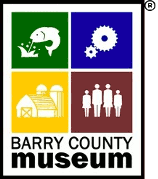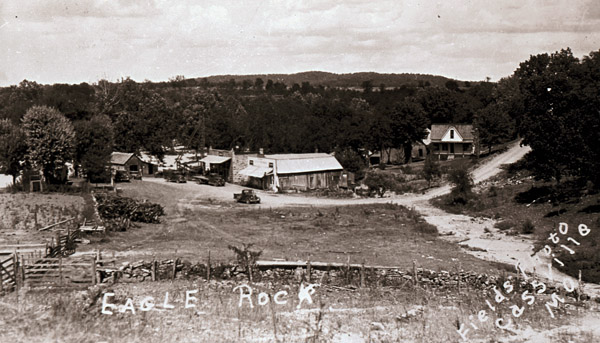 |
Eagle Rock 1930s |
Eagle Rock by Patricia Pettigrew from Back To Barry
Earliest known history of Eagle Rock dates back to the 1840's when stories were told about early settlers coming into this area from Kentucky, Tennessee, Illinois, and the Carolinas. Stories were told that an old lonely Indian still lived here in the hills. It is unknown who gave Eagle Rock its name, but it was named for the huge rocks west of the old Eagle Rock Store where eagles built their nest. The very first settlers were Greenberry Easley, the Haddocks, Alfred Reed family in 1842, Brims, Alridges, Currys, Millers, Sellers, and James. There were others, names unknown. Later came Mr. and Mrs. Dick Elam, Mr. and Mrs. Bill Ayres, Mr. and Mrs. John Easley, Mr. and Mrs. James Tucker (came from Tenn. to Ill. then to Eagle Rock in the spring of 1849), Mr. and Mrs. Ned Easley, Mr. and Mrs. Bill Lewis, Mr. and Mrs. Morse Farwell, Mr. and Mrs. Frank Tucker, Mr. and Mrs. Elbert Ball, Dr. and Mrs. C.G. Kelley, Mr. and Mrs. John Whittington, Mr. and Mrs. Wm. Whittington, Mr. and Mrs. Sam Skelton, Mr. and Mrs. Elisha Hall, and many others.
An interview with James Tucker in the March 19, 1896 Cassville paper, gives a birdseye view of Eagle Rock in 1849, "When I came here it was a wild country and very thinly settled, There were about ten houses on Roaring River and none on the side borders nearer than Butler Creek and Rock Creek, and Washburn and Cassville were our only trading points in the county. There was one weekly horse mail from Cassville to Carrollton, Arkansas and no post office between Cassville and Berryville at that time. There was one voting place on White River at what is known as the Green Easley place. We had a little Baptist Church here held under a shed. We had plenty of game of all kinds - bear, deer, turkey and all sorts of small game. There was one little pole school house in the township just high enough to walk in, and every man paid for all his own scholars as we had no school money and we did not have much school."
|
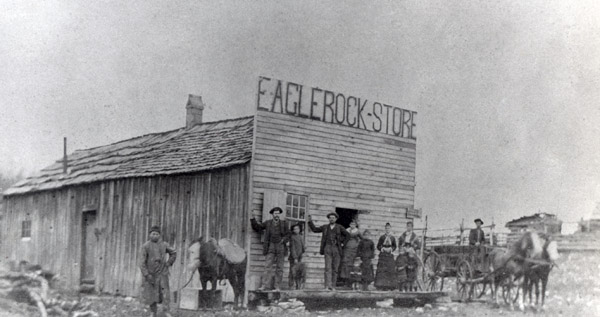 |
Eagle Rock Store |
Eagle Rock was then above where the bridge now crosses over Roaring River on Highway 86. This was where the local people spent their Saturdays shopping in the little country store and sitting on the bench in front of the store telling the latest news. Eagle Rock consists of Mano, Victory, Munsey, Eagle Rock, Mt. Zion, Roach, and Aix.
The Eagle Rock Post Office was first established in 1854 as the Roaring River Post Office. During that time there were seven postmasters. The post office was discontinued in 1864 and reestablished at Roaring River on May 16, 1871, with names as Ruble, Weathers, Homesby, Allen, and Farwell, serving as postmasters. In 1871 to 1877 a post office was located at Munsey. Henry Burris was the postmaster, starting May 16, 1871.
Joseph Munsey became postmaster November 19, 1872, and Mary Munsey, Oct. 16, 1877. In 1886 the Roaring River Post Office's name was changed to Eagle Rock Post Office (this may have been the time the community was named Eagle Rock). In 1894, Sam Gilmore was postmaster of Mano. From the late 1800's thru 1917 the office had eight postmasters by the names of Farwell, Larcey, Whittington, King, Holman, Ayres, and Skelton. Noel Curry, merchant and area leader, took the office from 1917 to 1918. Jean Curry became postmaster in 1925 and retired in 1971. Her son Willis Curry assumed the postmastership on April 1, 1971 until April 30, 1986. Cindy Rogers succeeded Willis until a permanent appointment was made. John Stringer was appointed by the U.S. Postal Service on September 12, 1986 and is now presently serving that position. |
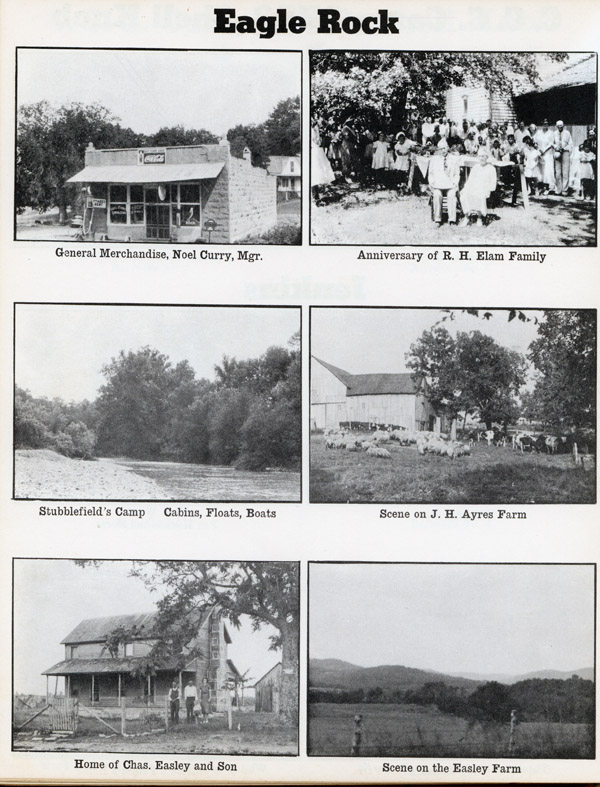 |
Eagle Rock in 1937 from Barry County in Pictures |
During the Civil War, from 1860 to 1864, several men from this area served in the war. In the August 23, 1894 Cassville paper, 14 area men attended the Civil War reunion. They were: Pvt. E. Williamson, Pvt. Jas. H. Callaway, Pvt. Jas Tucker, Pvt. George Reed, Pvt. John H. Burton, Pvt. George Smith, Pvt. B.F. Curry, Pvt. M.L. Scroggins, Pvt. A. Burris, Corp. John Davis, Pvt. John Whittington, Pvt. Jasper N. Skelton, Pvt. Daniel Garner, and Corp. T.E. Meadows. This was the Seventh Annual Reunion of Veterans and Sons of Veterans of Barry and adjoining counties of the Civil War, Munsey was the crossing point for some of the troops that were going to Pea Ridge. They crossed at Munsey and went up Pine Hollow. There at Munsey they had hid a cannon as they couldn't pull it over the hills. They had dumped cannon balls and shot in the river, reason unknown. Later while school was in session at Munsey the children would pick up the shot and play with it. The shot was used to play marbles and used in bean flips.
The Bushwhackers came through the Eagle Rock area putting fear in the local people. They came through raiding the farm houses and killing the men. My grandmother told stories about her mother hiding the family silverware and other important items in a hole above the Herman Ball place now, to keep the Bushwhackers from stealing them. Some say that some of the riders that were with the Bushwhackers were local men. They would seek out the men of the family and kill them. Alfred Reed, my step-great-grandfather was killed by the Bushwhacker near White River. The Curry girls (young women) took a sled to White River and brought back Mr. Reed and he was buried near his wife on the Charles Curry farm in a small cemetery on the banks of Roaring River. Sim Perse's father was sought out by the Bushwhackers because he was a black man. We don't know if he was killed by the Bushwhackers. Milo Russell had to hide in caves to keep the Bushwhackers from killing him, His daughters would sneak food up to Bowman's Cave to feed him,
In the late 1800's Eagle Rock, itself, was a fairly large settlement. It was larger then, than it is now. Now it takes in seven other small communities. In the 1850's Alfred Reed's brother had a mill on Roaring River which is now back and below Crump Taylor's residence. Later it was called the Roller Mill. In October 1894, Jim Whittington started a fine mill near the Reed Mill. This was used to grind corn, wheat, also had a store next to his mill. About this time another store was located west of the old Eagle Rock store now. It was owned by the Farwells (Ray and Walter Farwell's family). and later the Larceys (Julie Easley Cooper and Allie Easley Prier's family) owned the store. This store burned when Tom Garrett owned it. Later in the early 1900's the store was moved across the road to what we had called old Eagle Rock. It was owned by Bill Ayres, Richard Whittington, and Noel Curry. The second store beside it was owned by Lon Taggart. Lon Taggart sold it to Oman Ball in the last part of 1949. Oman Ball ran the store until the summer of 1952, he then sold it to Warren Swanson. The store burned while Warren Swanson was proprietor, losing everything that was in it.
|
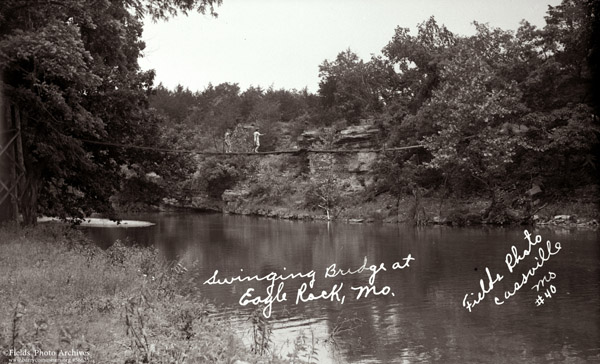 |
Swinging Bridge at Eagle Rock, Missouri |
In 1909 some of the men here got jobs cutting railroad ties for the railroad coming in. The ties were cut and slid down the bluff on White River (the bluff we now call the Tie Slide across the road from the Eagle Rock Motel). They were floated down the river to Branson where the ties were sold. The late 1800's and early 1900's were not all hard work and no play. On Saturday nights the local people would take turns having dances and parties at each other’s homes. One Saturday night they would go to John Munsey's home and do the two-step and then the next Saturday night to Bartolomew Stringer's house (Vernon and Johnny Stringer's great-grandfather), which was reported to have 83 people there. Can you imagine that many people in those tiny homes back then?
During this time some of the finest homes were built, they were considered fine in those days. Charley Curry's home was built in November of 1899. It stands near Roaring River and is still in the Curry family. Another was built during this time is the house Denny Ball's family lives in by Bill Ayers in the late 1800's. Also the Boone Haddock home that still stands, now owned by Jerry Thompson and Rosemary Thompson Burch. |
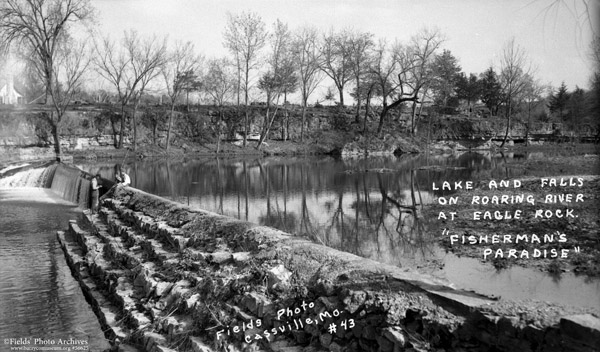
|
Lake and Falls on Roaring River at Eagle Rock |
In the 1920's thru the 1940's Saturday afternoon was the shopping day at Eagle Rock. Cream and eggs were taken to the store in exchange for groceries, maybe some yard goods for a dress. The men would go to the blacksmith shop (owned by Mr. and Mrs. Cap Bradford) to get a horse shod or plow point sharpened, hoe, or shovel made. In the later 1940's a man would bring movies to Eagle Rock on Saturday nights and set up a screen on the outside of the store between the store and the blacksmith shop, and show western movies. This was an exciting time for the youngsters. People would catch up on the community news and the latest gossip with friends at the stores. Eagle Rock Village consisted of two general merchandise stores, a post office in the back of one store, a gas powered hammer mill to grind feed for cattle, a church and a schoolhouse, also our very own doctor, Dr. Taylor.
Before 1930 there was an old water wheel mill on the east side (possibly the same mill Alfred Reed's brother built or the mill Whittington built in the 1800s on Roaring River below Crump Taylor's home. A dam was built to run the water down the millrace. The mill was used to make flour and meal. In the 1930's a Mr. Watt bought the mill property and connected the old mill into a generator that supplied electric lights to the store, church house, and school house.
Eagle Rock was not always a peaceful place to live in. There was a need for law and order in the 1800's and early 1900's. Quite often fights broke out and the losing man often died. It would start out as rough housing but ended up someone getting hurt or killed. In the early 1900's a man lost his life for calling a man a name. Grant Pyatt rode his horse to the General Store at Eagle Rock, stopping by relatives to ask if they needed anything at the General Store (this was the custom among neighbors helping each other out). The relatives needed kerosene so they gave Mr. Pyatt their kerosene can. As time went by Mr. Pyatt did not show up at the relatives with their kerosene. They later found out a Mr. Albert who lived up Pine Hollow, near Munsey, and Mr. Pyatt exchanged a few words. Mr. Pyatt called Mr. Albert a name and Mr. Albert pulled Mr. Pyatt off his horse and shot him. Mr. Pyatt died from the shot wound.
In 1894 one Robinson from Dry Hollow and Thomas Couch were running a horse race, and just before the race, Robinson, imitating the woolly wild west began indiscriminately firing his pistol, one ball going through the hat brim of H.W. Reading and two balls hitting a young mare belonging to Charley Curry. Robinson was arrested under warrant issued by R. Haddock. The supposition is that, if anyone had been hurt there would have been a hanging bee.
Arthur Ball, Silas Ball, Bob Tucker, and Jim Garrett and others were gambling on Roaring River near Munsey. Arthur Ball got into a fight with one of the boys and the other one cut him open with a knife. His intestines fell out and the boys pushed them back in and took Arthur to old Dr. Taylor, the village doctor, who lived on the Doc and Julie Skelton place across from the general store. Dr. Taylor sewed him up with black thread. Arthur lived at least thirty more years.
|
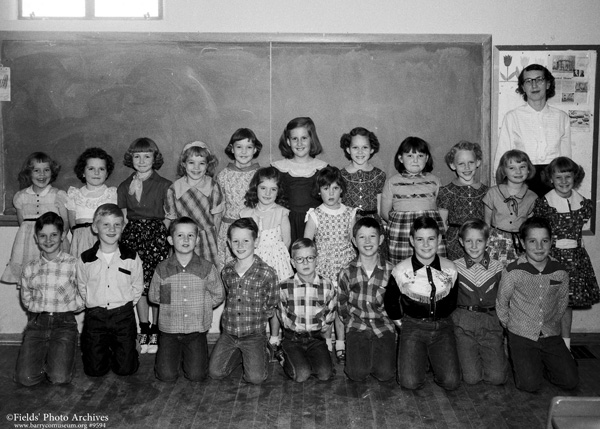 |
Eagle Rock School in 1957 |
Schools were scattered around the country side to compensate for all the children that lived in the area. There was a school at Munsey, Eagle Rock, one earlier located on what is now called the Leonard Prier place, one at Roaring River (still stands in the State Park), Mano, Victory, Mt. Zion, and Roach. These were one room schools, sometimes with 60 children attending, with one teacher. The average ages were 5 years to 17 years old. The kids would sometimes go through the 8th grade twice because they could not go to high school as there was no transportation or had to work to help earn the family living. Schools did not meet the nine months as they do now. They would meet in the months that the crops were not being planted and harvested. The children had to be home during this time.
The teachers in early 1900's at the Munsey School were: Thomas Reynolds, Claud Kisler, Homer West, Dan Brattin, Oscar Prier, Faye Poysal, May Walden, Jean Ball Curry, Grace Puitt, Hugh Haddock, Lily Hankins, Mr. Epperly, Gerldine Brooks, Hazel Corbin, Edith Prier, and Geneva Ball Indermuehle. There may have been others, but names unknown.
The schools were the gathering places for all the residents for social gatherings. They had games, Christmas programs, spelling bees, local music, and sometimes a revival was held at the school.
|
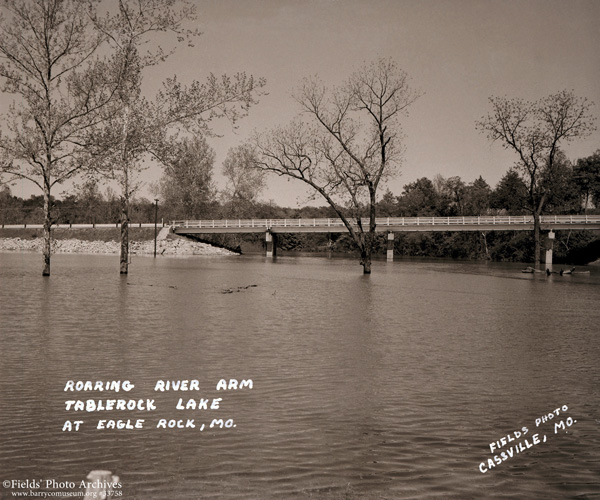 |
Roaring River Arm Table Rock Lake at Eagle Rock 1961 |
In the 1950's progress came to the little village. Table Rock Dam on White River was being built, changing the scenery, and standard of living. Many of the old timers had to sell their farms because of high water that would take their land. This brought in many new people from other places, sharing our love for this area. As the new highway (Highway 86) was being built, Noel Curry had a new general store built up on the hill near the new highway. He and his wife Jean also moved their house up on the hill which still stands. Mr. and Mrs. Denny Ball live there now.
We now have a Mitchell Plaza which contains many variety of shops, the Lakeview Grocery and Feed Store, real estate offices, 3 churches, a cafe, motels, and couple of construction companies, a bank, and a community center where people get together for fun. In the summer time we have lots of tourists enjoying the lake. We have a nice Arts and Crafts show every fall, Antique Show in the spring and other get-togethers in between. We have our own fire department, also our own ambulance service with the help of Axley Funeral Home of Cassville. Those in the fire and ambulance department are: Cliff Mitchell, Melissa Mitchem, Junior Gerster, Paula Carroll, Randy Carroll, Tom Ellis, Elbert Ash, Don Lahrl, Don Hixon, Butch Stringer, Pat Brown, James Williams, George Pettigrew, Patricia Pettigrew, Bill Navaree, Carolyn Navarree, and Robert Torbett.
As of 1988, we now have a helicopter pad to use in cases of emergencies. Our community is growing by leaps and bounds. Eagle Rock won 2nd place in our category and the Five Star Platte through the Missouri Community Betterment program. In order to achieve the Five Star Platte, Eagle Rock built a helicopter pad, a new chamber of commerce center, beautification of highway program, area is accessible to wheel chairs, and Jaws of Life is available for emergencies. |






